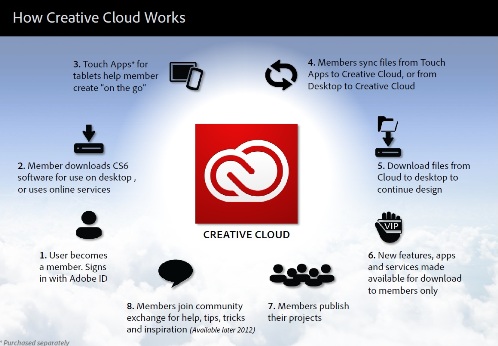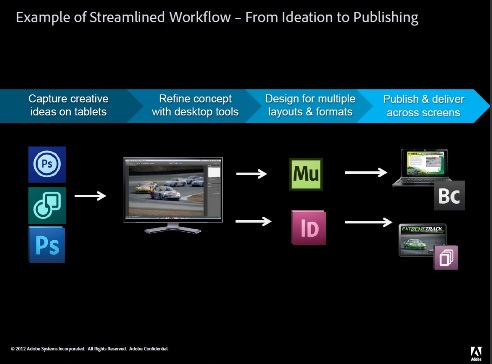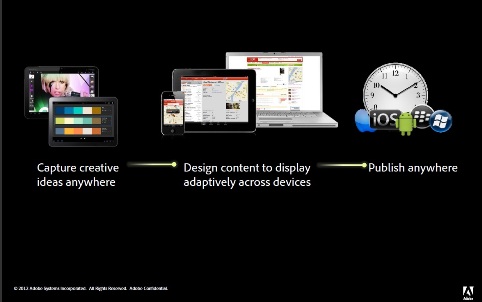With the launch of Creative Suite 6 (CS6), Adobe has realigned, tightened, and refocused its collection of software and targeted bundles into four disciplined groups. With Photoshop CS6 at the helm, CS6 reflects the updated, streamlined, real-world workflow of many creative operations. Adobe has long acknowledged that print and online creative projects were converging, and this version of Creative Suite demonstrates that.
For designers who jump back and forth between print and online projects, Adobe offers the $1899 Design and Web Premium package, featuring Photoshop Extended, Illustrator, InDesign, Flash Professional, Fireworks, Dreamweaver, and Acrobat X Pro. This packages together two formerly separate bundles-the Design Premium and the Web Premium.
Video professionals now have an expanded $1899 Production Premium suite featuring Premiere Pro, After Effects, Audition, Flash Professional, Illustrator, Photoshop Extended, and two brand new applications, Prelude and SpeedGrade. The reconstituted Production Premium was first revealed at the National Association of Broadcasters convention, which included a preview of Prelude for video ingest and logging, and SpeedGrade, for colour correction and finishing.
The $2599 Master Collection, as its name implies, includes all of the suite’s boxed software-12 standalone programs and two companion apps-Bridge with Photoshop, and Encore with Premiere Pro.
While Creative Suite 6 has debuted, it is not yet available for sale. Boxed and downloadable versions will be available within 30 days, and customers can preorder both the software and the Creative Cloud, of which it constitutes a vast part.
Concurrently with the release of Creative Suite 6 is Adobe’s brand new Creative Cloud, which, together with CS6, forms the backbone of Adobe’s new online subscription strategy. Macworld has more details specifically about Adobe’s plans for CS6 and Creative Cloud with this launch.
Photoshop and Photoshop Extended
While the world doesn’t begin and end with Photoshop, sometimes it seems as if it does, especially when upgrade time rolls around. Photoshop is Adobe’s flagship program and its oldest and most popular package. A huge amount of attention is generally paid to upgrading Photoshop within Adobe’s traditional 12-to-18-month upgrade cycle. This time was no different.
Since Photoshop CS6 was released as a public beta, Adobe reports there have been nearly one million downloads of the software worldwide-more than any public beta in Adobe’s history. Macworld’s was among them, and our Photoshop CS6 First Look explores the program’s many major new features in detail. Here are some of this highlights.
Dark Theme Photoshop CS6 has undergone an interface redesign that touts a streamlined presentation on a fresh dark theme. The program also extends its slate of content-aware tools to include two new tools: Content Aware Patch and Content Aware Move, alongside a gallery of new blur effects, a non-destructive crop tool, and a new Adaptive Wide Angle lens correction tool.
Related Stories
– Adobe After Effects techniques lead to convincing green-screen special effects
– Adobe Social to help marketers put ROI on social media
– Adobe steps up digital marketing push with new and upgraded products
…
Content Aware features Content-Aware Patch options let users select and duplicate one area of an image to fill in or “patch” a different area of the same image. It shares a high concept with the Clone tool, but it is a bit more subtle. Content-Aware Move lets users select and move an object to a new place in the image, as the program fills in the background behind the relocated object.
Layer enhancements Photoshop’s layers technology has also been overhauled in this version. With Photoshop CS6, vector layers now, for the first time, allow users to apply dashed lines and gradient strokes. Searchable layers help users quickly find the specific layers they seek.
Text Formatting A new type-rendering engine displays text more cleanly and clearly, and with more balanced anti-aliasing-especially at smaller point sizes. Paragraph Styles control the characteristics of groups of sentences or whole pages of type, and Character Styles can specify the look of individual letters, words, or phrases. You can employ styles across multiple documents in a project and make project-wide changes by altering specific style entries and have the changes flow through all documents.
Blur Gallery A simple interface with on-image controls facilitates photographic blur effects including tilt-shift, shallow depth of field, or blur between multiple focal points.
Camera Raw 7 It first appeared in Photoshop Lightroom 4, and now it’s included as a plug-in to Photoshop CS6, offering new, easier-to-use controls.
Photoshop CS6 offers improved, more intelligent auto corrections built on a database of similar image corrections. New painting features include erodible brush tips, a brand new GPU-accelerated Oil Paint filter, and skin tone aware selection and masking. Intuitive video creation and editing tools are also available in this upgrade.
The Extended version takes advantage of the Mercury Graphics Engine for GPU-powered 3D operations, including reflections and dragable shadows. Interface improvements offer easier, more responsive 3D controls.
For the Mac, Photoshop requires a multicore Intel processor with 64-bit support, Mac OS X 10.6.8 or 10.7, and 1GB of RAM. For Windows, it requires an Intel Pentium 4 or AMD Athlon 64 processor, Microsoft Windows XP with Service Pack 3 or Windows 7 with Service Pack 1, and 1GB of RAM.
InDesign
Adobe InDesign CS6, targeted to both print and online graphic designers, debuts new tools to help designers repurpose and adapt layouts for print, Web, and mobile devices. New features include Alternate Layout, Liquid Layout, Linked Content, and a set of Content Collector tools that let you re-use designs across different projects.
Alternate Layout InDesign’s Alternate Layout feature makes it easier to adapt a primary InDesign layout for various orientations, page sizes, or devices while retaining control over the main design. InDesign can add pages and copy content while each layout appears separately in the Pages panel. You can even copy and customize text styles for each layout.
Liquid Layout The Liquid Layout feature adjusts content in relationship to the page when you create an alternate layout. When you repurpose a layout for pages with different dimensions, you can apply liquid page rules to individual pages in your layout. Then, when you create an alternate layout, InDesign applies those rules to arrange content according to the new page size.
Linked Content This feature ensures that repeated content-text, images, or interactivity-remains consistent in the same document or across multiple documents. You can link anything in a frame, including transition times and other interactive settings.
Content Collector tools Quickly reuse text and objects in the same document or other InDesign documents with Content Collector tools-Content Collector, Content Conveyor, and Content Placer. The Content Collector tool lets you select the frame you want, place it in the Content Conveyor, and find the location in any document where you want to reuse the item. The Content Placer tool places the item on the page. Once you’ve placed an item, it disappears from the Content Conveyor. However, you can choose to leave an item in the Content Conveyor so that it will be available in any InDesign document.
PDF forms InDesign CS6 not only lets you design forms, you can also tweak form fields before exporting to PDF. Create text, radio buttons, check marks, combo boxes, signature fields, and more. You can include tooltips and determine the tab order for form fields.
Middle Eastern language support You can now get a Middle Eastern version of InDesign directly from Adobe. InDesign CS6 provides full support for Arabic, Hebrew, and other Middle Eastern languages, including eight Indian languages, making content localization smoother for global content creators.
Other productivity enhancements include the ability to align selected items in the layout to a specific object, calculate values directly within panels and dialog boxes, zoom in directly to a linked object when you view it in context from the Links panel, preview your layout in grayscale to proof it for a black-and-white device or printing, and more. A new Flexible Width feature, lets you automatically reflow text into additional columns when you resize a page.
On the Mac, InDesign requires a multicore Intel processor, Mac OS X 10.6.8 or 10.7, and 1GB of RAM (2GB recommended). For Windows, it requires an Intel Pentium 4 or AMD Athlon 64 processor, Microsoft Windows XP with Service Pack 3 or Windows 7, and 1GB of RAM (2GB recommended).
Fireworks
Fireworks CS6, targeted to Web artists and developers, provides an environment for creating and optimizing vector and bitmap images, themes, content, comps, wireframes, and mockups for Web and mobile designs. This new version is designed to make the program a better companion for Dreamweaver and other HTML editors. New features include jQuery mobile theme support, CSS sprites, CSS code extraction via the new Properties panel, improved swatch and optimization tools, and performance enhancements.
jQuery Mobile Theme Skinning This feature lets you create visual textures and designs for smart phones and tablets with the jQuery Mobile Framework, a JavaScript, touch-optimized Web framework that facilitates building websites for mobile devices. It works on a large number of desktop, smart phone, tablet, and e-reader platforms. When you build mobile Websites with jQuery Mobile, you can build from and modify the default theme. jQuery Mobile themes include multiple colour variations wherein each has a header bar, content body, and button states that you can mix and match. It is easy to use and includes Web-specific controls such as buttons, sliders, list elements, and more.
CSS Sprites Fireworks CS6 lets you build CSS sprites directly from your design comp in one step. CSS sprites decrease the loading time of images on your website by combining several images into single file, thus decreasing the number of server requests. The new CSS Sprite feature combines slices in your Fireworks source file, and then converts them into a single sprite image.
CSS Code Extraction and new CSS Properties panel This feature lets you extract CSS3 code from your designs and design elements. After extraction, you can copy and paste the code into a Dreamweaver file or another Web editor.
On the Mac, Fireworks requires a multicore Intel processor with 64-bit support, Mac OS X 10.6.8 or 10.7, and 2GB of RAM (8GB recommended). On Windows, it needs an Intel Pentium 4 or AMD Athlon 64 processor, Microsoft Windows XP with Service Pack 3 or Windows 7 with Service Pack 1, and 1GB of RAM (3GB recommended) for 32 bit or 2GB of RAM (8GB recommended) for 64 bit.
Dreamweaver
Adobe Dreamweaver CS6, targeted to Web designers and developers, builds HTML 5 and CSS3 sites, and lets you preview your design for smart phones, tablets, and computer screens simultaneously with the program’s enhanced Multiscreen Preview panel and accurate Live View.
Dreamweaver CS6 is now Cocoa-native and optimized for better Mac OS performance. Optimization also improves image editing features such as cropping, resizing, and resampling image files, allowing quick and efficient graphics tweaking in Design view and the Property inspector.
This new version lets you build native mobile applications for both Apple’s iOS and Google’s Android platform with jQuery Mobile and improved PhoneGap integration. It also features multiple viewing options, accurate HTML 5 rendering, improved FTP performance, and streamlined image editing tools.
Fluid Grid Layouts Dreamweaver CS6 introduces fluid grid layout starter templates to create flexible page layouts with a multicolumn design grid. You can construct fluid grid layouts in Design view, and then use Dreamweaver’s CSS3 authoring tools to incorporate the design. You can create three different adaptive layouts for the most common mobile, tablet, and desktop resolutions. After specifying the layout grid for each resolution, you can create fluid grid layout div elements (div tags) to build your overall page structure. Drag and resize the page regions to reposition them in relation to your layout grid.
Real-time Multiscreen Preview This new version features enhancements to the Multiscreen Preview panel, which lets you view three different screen sizes as well as run HTML 5 and CSS3 code in real time. You now can simultaneously preview your designs for smartphones, tablets, and computer screens, preview custom screen sizes, and test the behavior of your code for each device.
jQuery Mobile Themes You can now preview and apply themes and attributes to your designs as you design and develop applications for mobile devices. The new ability to access mobile themes makes them easier to work with. Now, you can use the jQuery Mobile Theme panel to find and preview prebuilt options. You can also create custom jQuery Mobile themes in Fireworks and access them within Dreamweaver.
Integrated PhoneGap Build Support With the new ability to integrate with Adobe’s PhoneGap Build service, you can package native mobile apps for iOS and other platforms such as Android, iOS, Blackberry, WebOS, and Symbian. With updated PhoneGap support in Dreamweaver, you can author HTML 5, CSS3, and JavaScript-based applications and let the PhoneGap Build service build the applications. You can add device-specific functionality, such as incorporating multitouch, geolocation and accelerometer features into your mobile projects. When the design is finished, use Dreamweaver to compile and package the app for delivery to devices.
Revised Live View The new version of Dreamweaver features enhancements to Live View to provide more accurate renderings of HTML 5 and CSS3 code. The new version of Live View lets you preview and manage your Web and mobile projects. You can preview HTML 5 video content and other rich media or use Live View with fluid grid layouts to design for mobile apps. Live View improvements are supported by the latest version of WebKit, the standard browser and device rendering engine.
W3C validation Dreamweaver CS6 uses the live W3C validation server for checking accuracy and high-quality code results for multiple versions of XHTML and HTML. Validating your code in Dreamweaver is the same as before, except that Dreamweaver now sends pages to the W3C validation service for processing.
Business Catalyst There’s updated integration between Dreamweaver and Adobe Business Catalyst, an all-in-one Web host that includes content management, shopping carts, module-based site features, reporting metrics, customer data, and email marketing. Business Catalyst lets you develop e-commerce sites and create online stores without writing server-side code.
CSS3 Transitions Dreamweaver now includes a new CSS3 Transition panel that lets you visually create smooth animation effects and colour fades between two CSS states without writing code. With the panel, you can target a CSS selector (including custom classes and IDs) and create transitions that morph between changes of a CSS property. The code generated by Dreamweaver is pure CSS3 and is supported by modern browsers and mobile devices. The transitions do not require JavaScript to display.
On the Mac, Dreamweaver requires a multicore Intel processor, Mac OS X 10.6 or 10.7, and 512MB of RAM. For Windows, it requires an Intel Pentium 4 or AMD Athlon 64 processor, Microsoft Windows XP with Service Pack 2 (Service Pack 3 recommended); Windows Vista Home Premium, Business, Ultimate, or Enterprise with Service Pack 1; or Windows 7, and 512MB of RAM.
Illustrator
Illustrator CS6, targeted to print and multimedia designers, Web and interactive designers, and video production artists, offers upgrades to features, technologies, and interface. New pattern tools, image tracing, and gradients on strokes enhance the tool’s feature set.
Adobe has overhauled the program’s engine and replaced it with the new Mercury Performance System, which uses the graphics processor as opposed to the CPU. Illustrator now offers native 64-bit support, accessing all the RAM on your system. Adobe has also freshened the interface of its 25-year-old illustration software.
Image Trace This feature lets you convert raster images to editable vectors via the program’s new tracing engine. This approach gives you quick results with image sensing, which automatically applies the most appropriate preset, while an Image Trace panel that presents you with options all in one place. Adobe says that the interface is more intuitive and interactive, giving you clean lines, accurate fitting, better colour recognition, and more reliable results.
Pattern Creation New pattern tools provide a different approach to crafting seamless, repeating vector patterns. On-artboard controls let you create and edit patterns interactively. One-click tiling arrangements let you experiment with different types of repeating tiles and pattern shapes that can be edited at any time. A new Patterns Options panel provides easy access to controls for creative exploration and instant previewing.
Gaussian Blur Enhancement Gaussian Blur and effects such as drop shadows and glows are now faster, and interaction with the tools is improved. With Gaussian Blur, you can now set a blur radius using a slider and preview instantly on the artboard, rather than in an intermediate dialog box.
Gradients on Strokes This new Illustrator version lets you apply gradients to your strokes-along the length, across the width, or within the stroke itself-all with control over placement and opacity.
On the Mac, Illustrator requires a multicore Intel processor with 64-bit support, Mac OS X 10.6.8 or 10.7, and 2GB of RAM (8GB recommended). On Windows, it needs an Intel Pentium 4 or AMD Athlon 64 processor, Microsoft Windows XP with Service Pack 3 or Windows 7 with Service Pack 1, and 1GB of RAM (3GB recommended) for 32 bit; 2GB of RAM (8GB recommended) for 64 bit.
Flash Professional
Flash Professional CS6, targeted to interactive designers and game developers, focuses on Adobe AIR runtime. This new version of Flash offers new sprite sheet generation, delivery of apps with a prepackaged Adobe AIR captive runtime, and access to device-specific capabilities with prebuilt native extensions.
Sprite Sheet Generation A sprite sheet is a single bitmap image containing multiple frames of one or more animations and symbols, with a separate data file that contains all of the coordinates of each of the states. By using sprite sheets, a browser or a game can load a single image and use the coordinates in the data file to show a specific state. Bitmap-based sprite sheets can have a dramatic effect on game performance, offering smooth playback by using the GPU as opposed to the main processor.
Prepackaged AIR App Creation With Flash Professional CS6, you can create and deliver applications with a prepackaged Adobe AIR captive runtime. This means that you can quickly test your content on different devices without having to install runtimes first, and end users can download, install, and use your content without requiring additional steps or downloads (other than accepting the licensing agreement).
Platform and Device-specific Access Prebuilt native extensions allow you to access to platform- or device-specific capabilities in your code. You can download native extensions at no charge. New extensions are added as new devices and capabilities are released.
Adobe AIR Mobile Simulation With tablets, smart phones, and even televisions and monitors offering support for touch interfaces (which, beyond basic functions like swiping and pinch zooming, may also include accelerometer and GPS functions), you can add engaging expression and interactivity to your content. New support for simulating these functions on the desktop lets you speed up testing and spend less time debugging.
Toolkit for CreateJS CreateJS is a collection of JavaScript libraries containing animation, sound, tweens, and tools that allow you to use the program’s animation and drawing capabilities to create HTML 5 content. It’s available as a free extension to Flash Professional CS6 owners and subscribers to Adobe Creative Cloud.
For the Mac, Flash Professional needs a multicore Intel processor, Mac OS X 10.6 or 10.7, and 2GB of RAM (3GB recommended). For Windows, it requires an Intel Pentium 4 or AMD Athlon 64 processor, Microsoft Windows XP with Service Pack 3 or Windows 7, and 2GB of RAM (3GB recommended).
Production Premium CS6
Adobe showcased Production Premium CS6 at the 2012 National Association of Broadcasters convention. Macworld published a hands on look at all the Production Premium software. Meanwhile, here’s the summary.
Premiere Pro Adobe’s flagship video editing software package is targeted to a wide range of users, such as editors and post-production pros, motion graphics designers, visual artists, and photographers. Updates include new features and improvements in interface, workflow, image stabilization, enhanced multicam editing, and an enhanced Mercury Playback Engine. The program provides native support for more pro level cameras and more powerful colour workflows.
Premiere Pro integrates well with other suite programs. Premiere Pro works with the new Adobe SpeedGrade, for colour grading workflows, or use it to import rough cuts and associated metadata from the new Adobe Prelude. The 64-bit Adobe Media Encoder lets you encode video faster and use the new Preset Browser to configure a single source for output to a combination of video and device formats. You can send Adobe Premiere Pro projects directly to Adobe Encore and After Effects without intermediate rendering via the faster Dynamic Link. Encore is now natively 64-bit, so you can produce completed DVD, Blu-ray Disc, and Web DVD projects faster.
For the Mac, this software requires a multicore Intel processor with 64-bit support, Mac OS X 10.6.8 or 10.7, and 4GB of RAM (8GB recommended). For Windows, it needs an Intel Core 2 Duo or AMD Phenom II processor with 64-bit support, Microsoft Windows 7 with Service Pack 1 (64 bit), and 4GB of RAM (8GB recommended).
After Effects This software, targeted to motion graphics designers, video editors, post-production professionals, and interactive designers, is used to create cinematic special effects and motion graphics. A new Global Performance Cache boosts productivity by saving almost all previews for instant recall. You can create and work with extruded text and shapes directly in After Effects. The new versiona also features Variable Mask Feathering, a new 3D Camera Tracker, Rolling Shutter Repair, and more high-quality, built-in effects.
For the Mac, the software requires a multicore Intel processor with 64-bit support, Mac OS X 10.6.8 or v10.7, and 4GB of RAM (8GB recommended). For Windows, it needs an Intel Core2 Duo or AMD Phenom II processor with 64-bit support required, Microsoft Windows 7 with Service Pack 1 (64 bit), and 4GB of RAM (8GB recommended).
Speedgrade A new addition to the Creative Suite, SpeedGrade is a native 64-bit program offering GPU-accelerated performance and support for formats like RAW, HDR, and stereoscopic content. SpeedGrade provides advanced colour grading capabilities to the Production Premium bundle. It works with digital cinema cameras such as ARRI ALEXA and RED, and with post-production interchange formats such as QuickTime, DPX, and OpenEXR. The software ensures that all your shots are accurately matched and every project is styled using layer-based tools for colour correction and look design.
On the Mac, SpeedGrade requires a multicore Intel processor with 64-bit support, Mac OS X 10.6.8 or 10.7, and 4GB of RAM (8GB recommended). For Windows, it requires an Intel Core i7 processor with 64-bit support, Microsoft Windows 7 with Service Pack 1 (64 bit), and 4GB of RAM (8GB recommended).
Prelude Targeted to producers, directors, and film editors, Prelude provides a unified interface for ingest and logging workflows, allowing you to work faster, stay organized, and generally streamline your production process. With this software, you can copy and transcode to your storage infrastructure and begin logging immediately, and add searchable markers and other temporal metadata. You can also create rough cuts with post-production notes that flow into Premiere Pro.
On the Mac, Prelude requires a multicore Intel processor, Mac OS X 10.6 or 10.7, and 1GB of RAM (2GB recommended). For Windows, it requires an Intel Pentium 4 or AMD Athlon 64 processor, Microsoft Windows XP with Service Pack 2 (Service Pack 3 recommended) or Windows 7, and 1GB of RAM (2GB recommended).
Audition This audio package provides an editing and mixing environment for video and broadcast workflows, integrating with Premiere Pro as well as third-party nonlinear editors and digital audio workstations. Audition offers new features for editing and sound design, such as real-time clip stretching, automatic speech alignment, and automatic pitch correction. It expands your production capacity with control surface support, recordable track automation, multiple clipboards, HD video playback, native 5.1 surround editing, and audio sweetening and restoration tools.
On the Mac, Audition requires a multicore Intel processor, Mac OS X 10.6.8 or 10.7, and 1GB of RAM; 2GB for HDV and HD playback. For Windows, it requires an Intel Core2 Duo or AMD Phenom II processor, Microsoft Windows XP with Service Pack 3 or Windows 7 with Service Pack 1 (32 bit or 64 bit), and 1GB of RAM; 2GB for HDV and HD playback.









